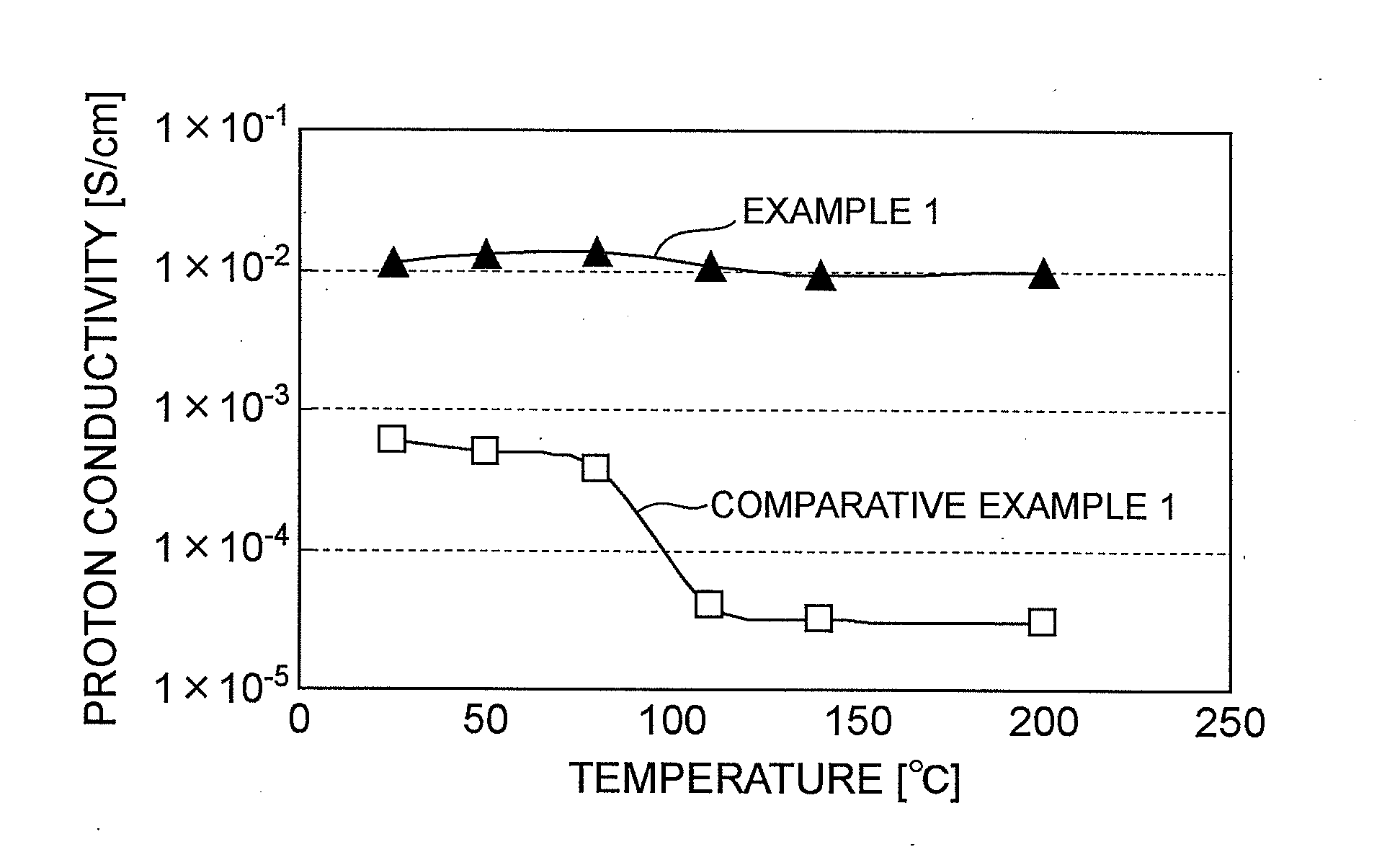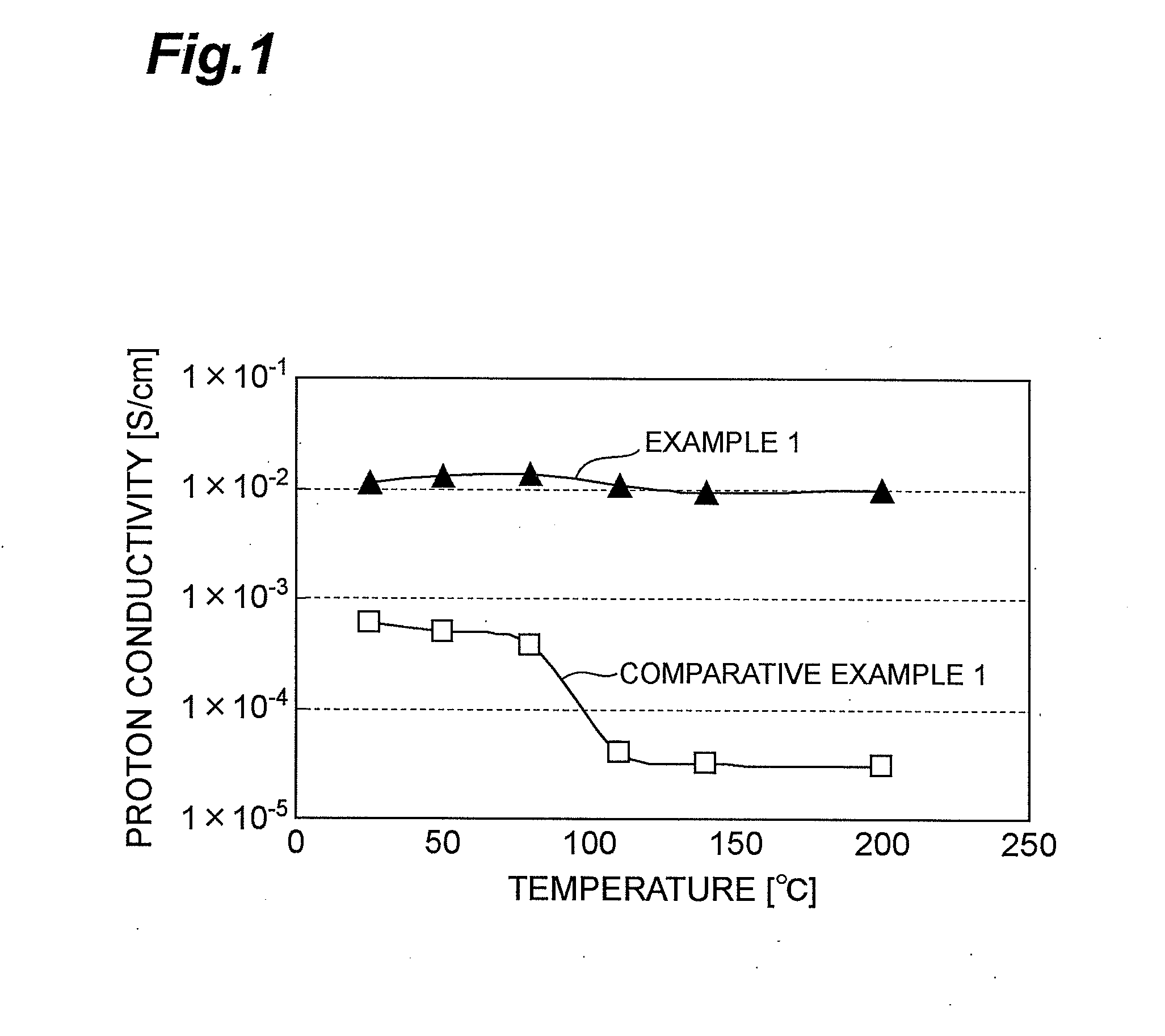Ion conductive composition, ion conductive film containing the same, electrode catalyst material, and fuel cell
a technology of ion-conductive materials and compositions, which is applied in the direction of cell components, final product manufacturing, sustainable manufacturing/processing, etc., can solve the problems of limiting the use of ion-conductive materials to low temperatures of not more than 100° c, reducing proton conductivity in the intermediate and high temperature range, and not having sufficient ionic conductivity in a practically wide temperature range. , to achieve the effect of no ionic conductivity
- Summary
- Abstract
- Description
- Claims
- Application Information
AI Technical Summary
Benefits of technology
Problems solved by technology
Method used
Image
Examples
preparation example 1
[0131]7.158 g of SnO2 (manufactured by Wako Pure Chemical Industries), 0.195 g of Al(OH)3 (manufactured by Wako Pure Chemical Industries), and 16.141 g of H3PO4 (85%, manufactured by Wako Pure Chemical Industries) were placed in a 300 mL beaker, and heated to 300° C. on a hot plate while stirring with a magnetic stirrer. During the heating, 100 mL of deionized water was added, as required, to adjust the viscosity. The entire amount of the viscous paste obtained after 1 hour of heating was placed in an alumina crucible, and heated to 650° C. in an electric furnace, taking 1.5 hours, maintained at that temperature for 2.5 hours, and then cooled to room temperature in 1.5 hours to obtain the metal phosphate. X-ray fluorescence measurements showed that molar ratio of the elements in the metal phosphate obtained was Al0.05Sn0.95P2O7. Hereinafter, this metal phosphate will be referred to as “Metal Phosphate 1”.
preparation example 2
Synthesis of Ion-Conductive Polymer
[0132]Following the method described in Example 1 of WO2006-095919, sodium 2,5-dichlorobenzenesulfonate, and chloro-terminal type polyethersulfone (Sumika Excel PES5200P, manufactured by Sumitomo Chemical) were polymerized using bis(1,5-cyclooctadiene)nickel(0) in the presence of 2,2′-bipyridyl, and the polyarylene block copolymer shown below was obtained. (In the formula, n and m represent the degree of polymerization of the respective structural units).
[0133]The ion exchange capacity of the polymer obtained was 2.2 meq / g. Hereinafter, this ion-conductive polymer is referred to as “Ion-conductive Polymer 1”.
preparation example 3
Synthesis of Ion-Conductive Polymer
[0134]Following the method described in Example 2 of WO2005-063854, the sulfonated polyarylene ether block copolymer shown below was obtained. (In the formula, n and m represent the degree of polymerization of the respective structural units).
[0135]The ion exchange capacity of the polymer obtained was 2.1 meq / g. Hereinafter, this ion-conductive polymer is referred to as “Ion-conductive Polymer 2”.
PUM
| Property | Measurement | Unit |
|---|---|---|
| Temperature | aaaaa | aaaaa |
| Temperature | aaaaa | aaaaa |
| Current | aaaaa | aaaaa |
Abstract
Description
Claims
Application Information
 Login to View More
Login to View More - R&D
- Intellectual Property
- Life Sciences
- Materials
- Tech Scout
- Unparalleled Data Quality
- Higher Quality Content
- 60% Fewer Hallucinations
Browse by: Latest US Patents, China's latest patents, Technical Efficacy Thesaurus, Application Domain, Technology Topic, Popular Technical Reports.
© 2025 PatSnap. All rights reserved.Legal|Privacy policy|Modern Slavery Act Transparency Statement|Sitemap|About US| Contact US: help@patsnap.com



